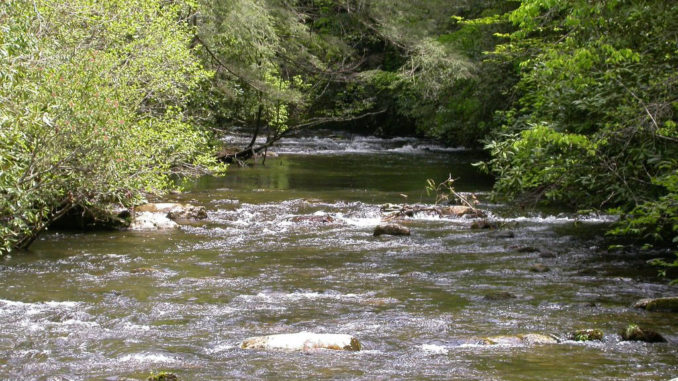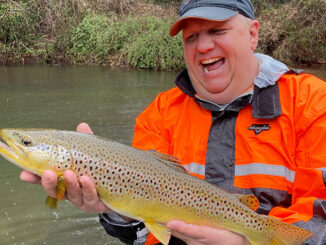
One of great Park streams,it’s a summer honey
Noland Creek in the Great Smoky Mountains National Park in Swain County is typical of hundreds of prime trout streams that crisscross the park: remote, scenic and full of trout.
The creek’s headwaters form high in the Smokies near Clingman’s Dome, and the creek flows south approximately 10 miles to the Tuckasegee River arm of Fontana Lake near Bryson City. As with most park streams, Noland has a mix of rainbow, brown and brook trout. Rainbows dominate the middle and upper sections, browns are limited mostly to the lower section, and brooks inhabit the headwaters.
Noland isn’t known as a lunker stream, although a few big browns and rainbows in the 20-inch range have been caught in the mile-long stretch from the Noland Creek trailhead to Fontana.
Steve Moore, chief fishery biologist for the park, said, “Most of the rainbows in Noland run 10 to 11 inches, which is a pretty good rainbow for the park.”
Eugene Shuler, a Swain County fishing guide who operates out of Cherokee, said, “On a scale of one to five, I’d give the lower section a rating of three and the upper section a rating of four.” The lower section, he said, gets the majority of fishing pressure because of its easy access, both from the lake and the Noland Creek Trail. “It’s not a high-production stream, but it is consistent,” he said.
Shuler seldom fishes the lower section. Instead, he hikes up to Mill Creek, about three miles from the trailhead, before he begins fishing. An old roadbed with a gentle grade offers easy hiking.
“It’s one of the few streams in the area that has better fishing in the summer than in the spring,” he said, explaining that the stream stays relatively cool, a factor he attributes to the heavy canopy and high elevation in the upper sections. “The best fishing is June through August.”
Shuler said fish are “very flighty” in the higher elevations of the creek, and it’s easy to get skunked on an outing. “I use long leaders,” he said, “anything from 9 ½ feet to 11 feet or longer with a 4X tippet. Presentation is very important.”
Insect hatches on Noland are much the same as hatches on any park stream. In early spring, Quill Gordon, Blue-Winged Olive, Blue Dun, Caddis, Hendrickson, March Brown and Dark Stone are excellent patterns for topwater fishing. In May, yellow patterns are effective, particularly: Yellow Stone, Golden Stone, Yellow Mayfly, Yellow Palmer and Yellow Humpy, as well as Light Cahill, female Adams and Pink Lady. Suggested spring nymph patterns include: My Pet, Pheasant Tail, Hare’s Ear, Zug Bug, Stick Bait, Secret Weapon, Tellico, Stick Bait, Dark Stone and Yellowhammer.
Terrestrials are the preferred patterns for early and late summer.
One of the bonuses of fishing the upper section of Noland Creek is access to several tributaries that have good populations of brook and rainbow trout; some of these streams have only brook trout.
Tributaries include Mill Creek, which has rainbow trout in the lower part and brook trout in the upper part; Springhouse Branch, which contains only rainbow trout; Bald Branch, Salola Branch and Clingman’s Creek, which are brook trout streams.
Noland Creek, Noland Divide and the town of Noland all were named for Andrew Noland, the first white settler in the area. The old town site was flooded with the lake was impounded. Foundations and ruins of old homesteads are visible all along the trail to Salola Valley, which once was a thriving community.
Six backcountry camping sites are on the Noland Creek Trail, beginning at the Noland Creek embayment at Fontana to Bald Creek, about eight miles north of the lake. All camping in the backcountry is restricted to designated campsites. Backcountry camping permits are required for overnight stays in the park. Because the Noland Creek Trail is popular with both hikers and horseback riders, camping sites usually are full on weekends in the summer and fall.
Fishing is limited to artificial flies or lures with a single hook. The limit is five fish per day, and the minimum size is seven inches. Only a basic North Carolina fishing license is required in the park.
To get there, from downtown Bryson City at the old Swain County Courthouse, go north on Everette Street, cross the bridge and continue straight on Fontana Road (SR1364) for three miles to the park entrance. The road then becomes Lakeview Drive. Continue five miles to the Noland Creek bridge. Just before you reach the bridge, a parking area will be on the left. A trail from the parking lot leads down to the Noland Creek Trail, which runs parallel to the creek. The Tuckasegee River arm of Fontana Lake is one mile downstream to the south.





Be the first to comment